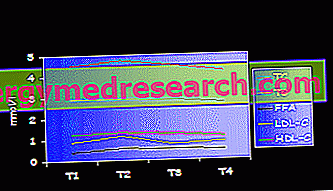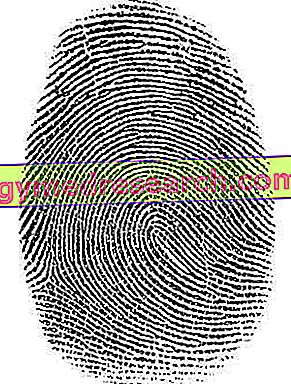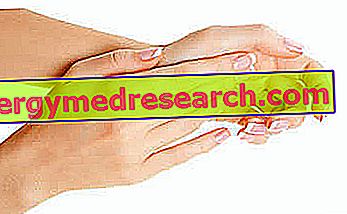By Dr. Gianpiero Greco
The following studies analyze the physiological responses of Judo practitioners. It will be possible, on the basis of the research results, to draw up a precise athletic preparation program and provide suitable indications on food supplementation.
The average heart rate recorded during the fight is 92% (182 bpm) of the maximum (198 bpm) measured at VO2max (55 ml / min / kg).
This would suggest a partially anaerobic power activity; instead an increase in plasma FFA, glycerol and triglyceride concentrations as well as total and HDL cholesterol was observed.

T1: values at rest
T2: values at 3 minutes after the fight
T3: values 60 minutes after the fight
T4: values at 24 after the fight

What can all of this depend on?
From the total duration of the exercise, which includes the 20 minutes of heating and the whole length of the fight.
From the metabolic adaptations induced by the reduced availability of carbohydrates, which could be limited to ensure a rapid resynthesis of glycogen after training.
From hormonal adaptations elicited by training such as catecholamine sensitivity, which improves lipolytic activity.
The increased activity of lipoprotein lipase causes an increase in HDL cholesterol, which plays a very important role in the FFA transport system.
Furthermore, an increase in plasma ammonia concentrations was observed.

It could be the consequence of the reduced availability of muscle glycogen, which damages ATP resynthesis and leads to the accumulation of AMP as well as its greater catabolic activity due to activation of type II fibers with the appearance of peripheral fatigue.


The increase in concentrations of uric acid also depends on the catabolism of the AMP and is an indicator of the availability of carbohydrates and muscle glycogen reserves; moreover, it plays a role in the oxidative defense of muscle during exercise.
Increased concentrations of urea indicate the activation of protein catabolism.


In the 60 minutes following the fight, the plasma levels of triglycerides, free fatty acids and glycerol remained high.
This indicates that lipolysis participates in the resynthesis of muscle glycogen reserves offering FFA as energy substrates and glycerol as a substrate for hepatic neoglucogenesis.
IN SUMMARY:
- Muscle glycogen is not the only substrate used during a judo fight.
- The lipid and protein metabolism is stimulated, and this confirms the remarkable activity of the oxidative processes.
- The anaerobic alactacid mechanism certainly makes a significant contribution given the technical characteristics.
- The anaerobic mechanism is active with average plasma lactate levels of 12.3 mmol / l.
- Considerable factors could affect the use of energy substrates, including the availability of carbohydrates, adaptation to training and metabolic stress.
Bibliography
Callister R., Callister RJ, Fleck SJ, Dudley GA: Physiological and performance responses to overtraining in elite judo athletes. Med. Sci. Sports Exerc. 22: 816-824, 1990.
Callister R., Callister RJ, Staron RS, Fleck SJ, Tesch P., Dudley GA: Physiological characteristics of elite judo athletes. Int. J. Sports Med. 12: 196-203, 1991.
Chinda D., Umeda T., Shimoyama T., Kojima A., Tanabe M., Nakaji S., Sugawara K .: The acute response of neutrophil function to a bout of judo training. Luminescence 18: 278-282, 2003.
Degoutte F., Jouanel P., Filaire E .: Energy demands during a judo match and recovery. Br. J. Sports Med. 37: 245 - 249, 2003.
Ebine K., Yoneda I., Hase H .: Physiological characteristics of the exercise and findings of laboratory tests in the Japanese elite judo athletes. Médecine du Sport 65:73 - 79, 1991.
Filaire E., Sagnol M., Ferrand C., Maso F., Lac G .: Psychophysiological stress in judo athletes during competitions. J. Sports Med. Phys. Fitness 41: 263-268, 2001.
Franchini E., Yuri Takito M., Yuzo Nakamura F., Ayumi Matsushigue K., Peduti Dal'Molin Kiss MA: Effects of recovery type after a judo combat on blood lactate removal and on performance in an intermittent anaerobic task. J. Sports Med. Phys. Fitness 43: 424-431, 2003.
Salvador A., Suay F., González-Bono E., Serrano MA: Anticipatory cortisol, testosterone and psychological responses to judo competition in young men. Psychoneuroendocrinology 28: 364-375 , 2003.
Serrano MA, Salvador A., Gonzàlez-Bono EG, Sanchis C., Suay F .: Relationships between recall of perceived exertion and blood lactate concentration in a judo competition. Percept Mot. Skills 92: 1139-1148, 2001.
Suzuki M., Nakaji S., Umeda T., Shimoyama T., Mochida N., Kojima A., Mashiko T., Sugawara K .: Effects of weight reduction on neutrophil phagocytic activity and oxidative burst activity in female judoists. Luminescence 18: 214-217, 2003.
Umeda T., Nakaji S., Shimoyama T., Yamamoto Y., Totsuka M., Sugawara K .: Adverse effects of energy restriction on myogenic enzymes in judoists.J. Sports Sci. 22: 329-338, 2004.


